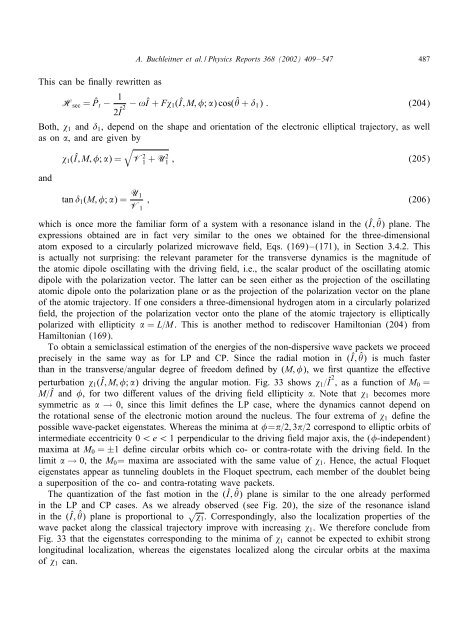Non-dispersive wave packets in periodically driven quantum systems
Non-dispersive wave packets in periodically driven quantum systems
Non-dispersive wave packets in periodically driven quantum systems
Create successful ePaper yourself
Turn your PDF publications into a flip-book with our unique Google optimized e-Paper software.
A. Buchleitner et al. / Physics Reports 368 (2002) 409–547 487<br />
This can be nally rewritten as<br />
Hsec = ˆPt − 1<br />
2Î 2 − !Î + F 1(Î; M; ; ) cos( ˆ + 1) : (204)<br />
Both, 1 and 1, depend on the shape and orientation of the electronic elliptical trajectory, as well<br />
as on , and are given by<br />
and<br />
1(Î; M; ; )=<br />
tan 1(M; ; )= U1<br />
<br />
V2 1 + U2 1 ; (205)<br />
V1<br />
; (206)<br />
which is once more the familiar form of a system with a resonance island <strong>in</strong> the (Î; ˆ ) plane. The<br />
expressions obta<strong>in</strong>ed are <strong>in</strong> fact very similar to the ones we obta<strong>in</strong>ed for the three-dimensional<br />
atom exposed to a circularly polarized micro<strong>wave</strong> eld, Eqs. (169)–(171), <strong>in</strong> Section 3.4.2. This<br />
is actually not surpris<strong>in</strong>g: the relevant parameter for the transverse dynamics is the magnitude of<br />
the atomic dipole oscillat<strong>in</strong>g with the driv<strong>in</strong>g eld, i.e., the scalar product of the oscillat<strong>in</strong>g atomic<br />
dipole with the polarization vector. The latter can be seen either as the projection of the oscillat<strong>in</strong>g<br />
atomic dipole onto the polarization plane or as the projection of the polarization vector on the plane<br />
of the atomic trajectory. If one considers a three-dimensional hydrogen atom <strong>in</strong> a circularly polarized<br />
eld, the projection of the polarization vector onto the plane of the atomic trajectory is elliptically<br />
polarized with ellipticity = L=M. This is another method to rediscover Hamiltonian (204) from<br />
Hamiltonian (169).<br />
To obta<strong>in</strong> a semiclassical estimation of the energies of the non-<strong>dispersive</strong> <strong>wave</strong> <strong>packets</strong> we proceed<br />
precisely <strong>in</strong> the same way as for LP and CP. S<strong>in</strong>ce the radial motion <strong>in</strong> (Î; ˆ ) is much faster<br />
than <strong>in</strong> the transverse=angular degree of freedom de ned by (M; ), we rst quantize the e ective<br />
perturbation 1(Î; M; ; ) driv<strong>in</strong>g the angular motion. Fig. 33 shows 1=Î 2 , as a function of M0 =<br />
M=Î and , for two di erent values of the driv<strong>in</strong>g eld ellipticity . Note that 1 becomes more<br />
symmetric as → 0, s<strong>in</strong>ce this limit de nes the LP case, where the dynamics cannot depend on<br />
the rotational sense of the electronic motion around the nucleus. The four extrema of 1 de ne the<br />
possible <strong>wave</strong>-packet eigenstates. Whereas the m<strong>in</strong>ima at = =2; 3 =2 correspond to elliptic orbits of<br />
<strong>in</strong>termediate eccentricity 0 ¡e¡1 perpendicular to the driv<strong>in</strong>g eld major axis, the ( -<strong>in</strong>dependent)<br />
maxima at M0 = ±1 de ne circular orbits which co- or contra-rotate with the driv<strong>in</strong>g eld. In the<br />
limit → 0, the M0= maxima are associated with the same value of 1. Hence, the actual Floquet<br />
eigenstates appear as tunnel<strong>in</strong>g doublets <strong>in</strong> the Floquet spectrum, each member of the doublet be<strong>in</strong>g<br />
a superposition of the co- and contra-rotat<strong>in</strong>g <strong>wave</strong> <strong>packets</strong>.<br />
The quantization of the fast motion <strong>in</strong> the (Î; ˆ ) plane is similar to the one already performed<br />
<strong>in</strong> the LP and CP cases. As we already observed (see Fig. 20), the size of the resonance island<br />
<strong>in</strong> the (Î; ˆ ) plane is proportional to √ 1. Correspond<strong>in</strong>gly, also the localization properties of the<br />
<strong>wave</strong> packet along the classical trajectory improve with <strong>in</strong>creas<strong>in</strong>g 1. We therefore conclude from<br />
Fig. 33 that the eigenstates correspond<strong>in</strong>g to the m<strong>in</strong>ima of 1 cannot be expected to exhibit strong<br />
longitud<strong>in</strong>al localization, whereas the eigenstates localized along the circular orbits at the maxima<br />
of 1 can.











